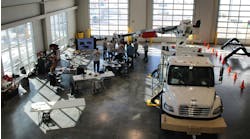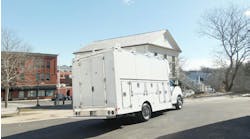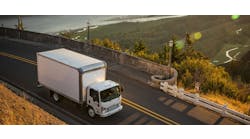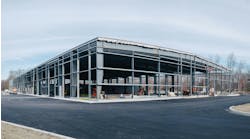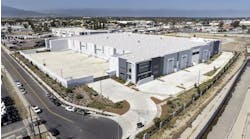Experts investigate exigency, impact of electric vehicles, autonomous trucks and solar power on freight transportation
The year 2015 came and went, and we’re still waiting for the flux capacitor, which, as Doc Brown explained in Back to the Future, makes time travel possible for DeLoreans and, presumably, other vehicles.
But the future of transportation has arrived in other ways, including the emergence of electrified trucks, solar-powered equipment and, yes, self-driving cars.
Industry insiders provided the latest outlook on all three areas, and discussed the likely impact of “future vehicles” on freight transport, during the 2018 FTR Transportation Conference in Indianapolis IN.
Electric vehicles
Rick Mihelic, director of future technology studies for the North American Council for Freight Efficiency (NACFE), dissected the arguments for and against electric trucks during his presentation, “Electric Vehicles—Charging the Future of Freight.”
“Electric trucks are polarizing,” Mihelic said.
“On one end of the spectrum, you’ve got zealots who are telling you electric trucks are the end of diesel as we know it today. Then, on the other end of the spectrum, you’ve got equally rabid opponents telling you electric trucks just are not viable. Somewhere in between those two is a space where there are a number of technologies available to fleets that help them … get a lower bottom line out of their operations, and electric trucks are in that space.”
NACFE weighed the pros and cons in four categories—weight, technology, cost and charging infrastructure.
Regarding the vehicle’s gross vehicle weight rating (GVWR), the council found no reason to wait on EVs. When electrifying a Class 8 diesel truck, as much as 8,000 pounds in engine, transmission, drive lines, emissions systems, fluids and more come out before electric components go in.
“It’s very feasible to build a weight-neutral truck that operates for a majority of the market,” Mihelic said.
NACFE identified more than 30 commercial electric vehicle (CEV) platforms making headlines, some simply as concepts, but others as prototypes, test vehicles and production-ready designs already in service, especially in the transit market, along with several charging systems US manufacturers are producing today or planning to roll out in the near future.
“The conclusion is, yes, the technology is ready, but electric trucks are right at the start of the innovation that has to prove it,” Mihelic said. “They need a lot more vehicles on the road, a lot more miles, (and) they need field history.
“That history has to get fed back to the manufacturers, and they have to iterate on it and make the products better.”
They also must make them cheaper, but as with most technologies, including high-tech devices like laptops and cell phones, performance is expected to increase as prices drop over time.
That’s the key to positive returns on investment without government incentives.
“There are a couple of manufacturers out there who’ve been developing trucks from a clean-sheet approach, and they’re looking at coming up with a cost-neutral electric truck without incentives, grants and rebates,” Mihelic said.
The final factor for widespread adoption is charging infrastructure.
That’s a new concern for purchasers considering switching from diesel, which is readily available at every truck stop, to electric, but Mihelic said it’s also an opportunity for businesses to rethink how they power fleets in an electric frontier, providing plenty of potential for innovation.
“While infrastructure may appear to be roadblocks to some, they’re business opportunities for others,” Mihelic said.
Autonomous trucks
Stephan Keese, a senior partner with Roland Berger, shared his company’s perspective on autonomous vehicles in his presentation, “Impact of Autonomous Trucks on the US Trucking Industry,” in which he highlighted the technology’s potential impact on industry business models.
Roland Berger, in its long-term study of autonomous trucks, used SAE’s definition of automation, which includes stages ranging from no automation (Stage 0) to full automation (Stage 5).
“The majority of new vehicles in the US, basically 90 percent, are today Stage 1, which means they have driver assistance functionality,” Keese said. “That means the driver still is fully engaged but typically can be feet off or hands off … so the vehicle’s really helping him in operating.”
Stage 2, or partial automation, still requires full engagement, but drivers can be both hands and feet with features like traffic jam assist, lane-change assist and predictive powertrain control. Keese said major OEMs are taking these feature to market in “12 to 18 months.”
Stages 3-5 are further off—and the most interesting. By Stage 4, vehicles are driving themselves, and Roland Berger sees that phase coming in the next “four to five” years, with early Stage 4 applications already in limited use.
“The hardware technology is about 95%-98% there,” Keese said. “It’s currently all about the software, the use-cases, and getting the challenges out of the vehicles and making them safe for rollout.”
The long-term goal, Keese said, is to put fully automated, driverless Stage 5 trucks—which, he was careful to point out, are different from platooning trucks which use wireless links to sync multiple trucks to a lead truck with a driver—in “unconfined traffic,” but that’s more than a decade away.
So how can autonomous tech help businesses in the meantime? Transfer hubs, Keese says. These hubs, separate from the first and last mile, would be big parking lots connected to lower-density highways, allowing for deployment of Stage 4 vehicles between hubs, restricted only by refueling.
“You separate, completely, the autonomous long-haul section from the short haul, and the whole network can be combined and connected through transfer hubs, where the trailer is handed from one tractor to another,” Keese said.
Making this model work requires real estate and autonomous vehicles equipped with the right hardware, including sensors, vehicle controls, safety backup systems and computing power, most of which is readily available today, leaving scaling the technology, and reducing cost, as the biggest barrier.
Current research is centered on spatial imaging, mapping and path-finding controls.
“The total incremental cost of this technology is roughly $30,000 by 2025, (with) $15,000 of that accounting for the material cost, about $10,000 accounting for the software cost, and the final $5,000 being margin the OEMs likely will charge their customers,” Keese said.
“Those costs, after the market matures, will be greatly reduced to about $15,000-$20,000, making it very affordable by the end of the next decade.”
That still may sound high, but Keese says the benefits, including lower operating costs, greater efficiency and improved asset utilization—automated trucks can operate 24 hours a day— outweigh the cost.
But achieving maximum benefit requires most states to pass laws allowing for driverless vehicles. The fewer states who come on board, the less the overall advantage.
An increase in automated trucks also will impact the size and composition of fleets, and eventually the aftermarket, as fleets become younger by retiring older, conventional sleeper-cab trucks and replacing them with automated vehicles with higher utilization.
“If we assume a quarter of the freight is going to shift from conventional to automated trucks, that would mean you take approximately 1 million trucks out of the market and replace them with 500,000 highly automated trucks (because) the utilization … is roughly twice that of a conventional truck,” Keese said.
Solar power
When it comes to power commercial vehicles, autonomous or otherwise, much of the focus is on electricity and alternative fuels.
Don’t forget about solar energy, says Jeff Kauffman. The president of Tahoe Ventures shined light on solar solutions during his presentation, “Alternative Energy Solutions and Vehicles—The Solar Wave.”
Fleets currently face many challenges, including fuel prices, maintenance costs, increasing battery power usage from the addition of equipment and function, like telematics, government regulations and environmental compliance, including a renewed focus on decreasing engine idle time.
Some fleets are attacking power and idle issues with auxiliary power units (APUs), but these have their own maintenance and operational costs, Kauffman said. Enter solar, which helps maintain a battery’s charge, whether the goal is reducing engine idling, or the power drained from a battery.
“Basically, you’re going to put solar panels on the vehicle,” Kauffman said. “Those will go into a charge controller, which then can either go toward the alternator, and reduce the strain on the alternator—which actually improves miles per gallon while you’re running on the highway—directly into the truck batteries to recharge, or it can go into another battery operator, either stored in auxiliary batteries for use later, run the AC, or run what we call hotel loads (refrigerators, microwaves, etc).”
With Total Cost of Ownership (TCO) of EVs already nearing a break-even point vs. the purchase of a diesel truck, Kauffman said, they’re coming, and solar can help accelerate the rate of adoption.
Solar also provides plenty of utility today, including extending truck battery life—and the life of liftgate batteries and motors—by maintaining a more consistent charge, increasing non-idle HVAC and hotel load times for drivers on break, and saving on miles per gallon by reducing stress on the alternator.
“The paybacks, before we take into account any credits or investment tax benefits, are anywhere between one to two years,” Kauffman said. “Now, on a truck asset of five to six years, you’re thinking, ‘Not a big deal.’ On a trailer asset of 12 to 15 years that’s a very big deal. When I get back to credits, now my break-even comes under one year, on a 15-year asset, and depending on your use that could be saving anywhere from $3,000 to $10,000 per year.”

